Dialer Node Configuration
The dialer node allows you to configure the dialer details and the team that is responsible to manage the calls. Some of these options are configured in the Control Hub. Please contact the support team if the intended values do not appear in the respective drop-downs.
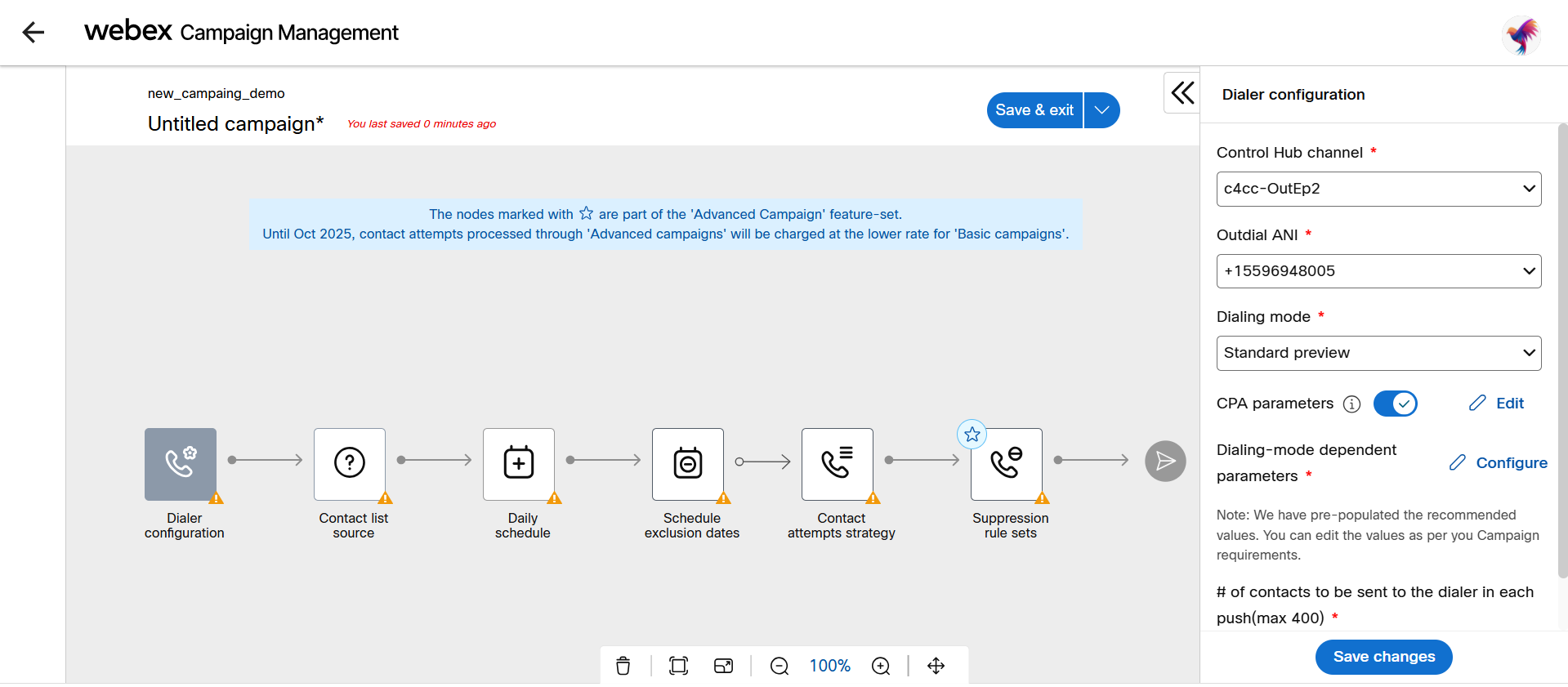
Follow these steps to configure the dialer configuration:
- Select the Dialer configuration node, the right pane will display the options you can configure.
- Select the Entry point from the drop-down. The expected value will be configured from Control Hub.
- Select the Outbound caller ID from the drop-down. The expected value will be configured from Control Hub.
- Select the Dialing mode from the drop-down. Based on the selected mode, additional options will appear.
- Configure CPA parameters: Enable or disable for all calls within this campaign. The default recommended values are applied to each parameter, which you can adjust to suit your specific use case.
- AMD (Answering machine detection: Determines if CPA should enable answering machine detection algorithm. CPA parameters must be enabled for AMD detection.
- Terminating tone detection: Determines if CPA should wait for the terminating tone of a voicemail before concluding. AMD detection must be enabled for terminating tone detection.
- Min silence duration (100 - 1000): The number of milliseconds required to classify a call as voice detected.
- Call analysis period (1000 - 10,000): The number of milliseconds spent analyzing the call.
- Min value speech (50 - 500): The minimum number of milliseconds of voice required to classify a call as voice detected.
- Max time analysis (1000 - 10000): The maximum number of milliseconds allowed for analysis before identifying a problem as dead air.
- Max Term tone Analysis (10000 - 60000): The maximum number of milliseconds the dialer analyzes an answering machine voice message looking for a termination tone.
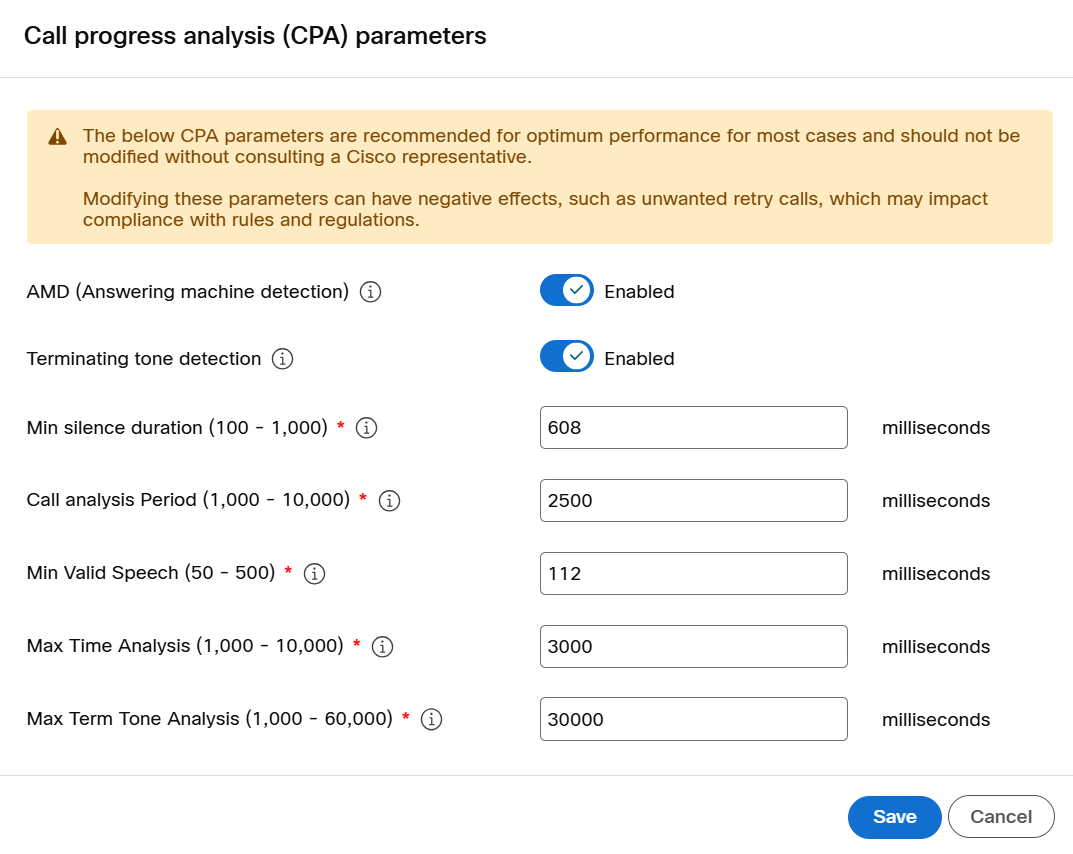
- Configure Dialing mode dependent parameters. All these parameter values are pre-defined based on the dialing mode selected, If you need to change any parameters you can do so.
The recommended values are pre-populated. You can edit the value as per you Campaign requirements.
- Configure the number of contacts to be sent to the dialer in each push. the maximum value is 400.
- Click Save changes.
Dialing mode dependent parameters
Standard preview dialing mode dependent parameters
- No answer ring limit (16-80): It refers to the number of times a phone rings before a call is considered unanswered and is either forwarded or sent to voicemail. This limit can be configured within the range of 16 to 80 rings. The default value is 32.
- Preview offer timeout (max 7200): It refers to the time an agent has to accept or reject a call before the system considers the agent unavailable for that call. The maximum allowed timeout for a preview offer is 7200 seconds, which is equivalent to 2 hours. The default value is 600 seconds.
- Auto action after preview timeout: After preview timeout an agent session will usually be released back to the system and the call will be terminated. The agent can then accept or reject the call during the preview time (defaulting to 10 minutes). After the timeout, the system handles the call, often returning it to the dialer list for the next available agent. The default value is Skip.
- Disable action for preview: You can select Skip or Remove.
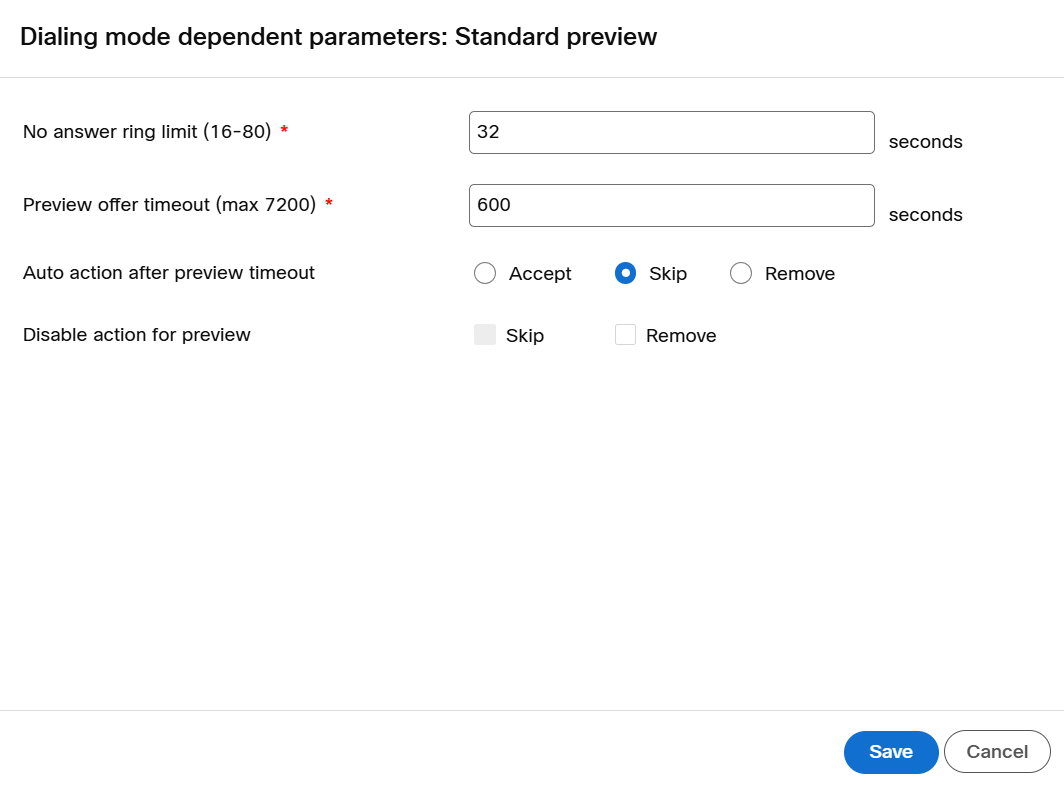
Direct preview dialing mode dependent parameters
- Preview offer timeout (max 7200): It refers to the time an agent has to accept or reject a call before the system considers the agent unavailable for that call. The maximum allowed timeout for a preview offer is 7200 seconds, which is equivalent to 2 hours. The default value is 600 seconds
- Auto action after preview timeout: After preview timeout an agent session will usually be released back to the system and the call will be terminated. The agent can then accept or reject the call during the preview time (defaulting to 10 minutes). After the timeout, the system handles the call, often returning it to the dialer list for the next available agent. The default value is Skip.
- Disable action for preview: You can select Skip or Remove.

Progressive dialing mode dependent parameters
- Dial rate (1-10): It refers to the number of outbound calls dialed out from a single port. The default value is 1.
- No answer ring limit (16-80): It refers to the number of times a phone rings before a call is considered unanswered and is either forwarded or sent to voicemail. This limit can be configured within the range of 16 to 80 rings. The default value is 32.
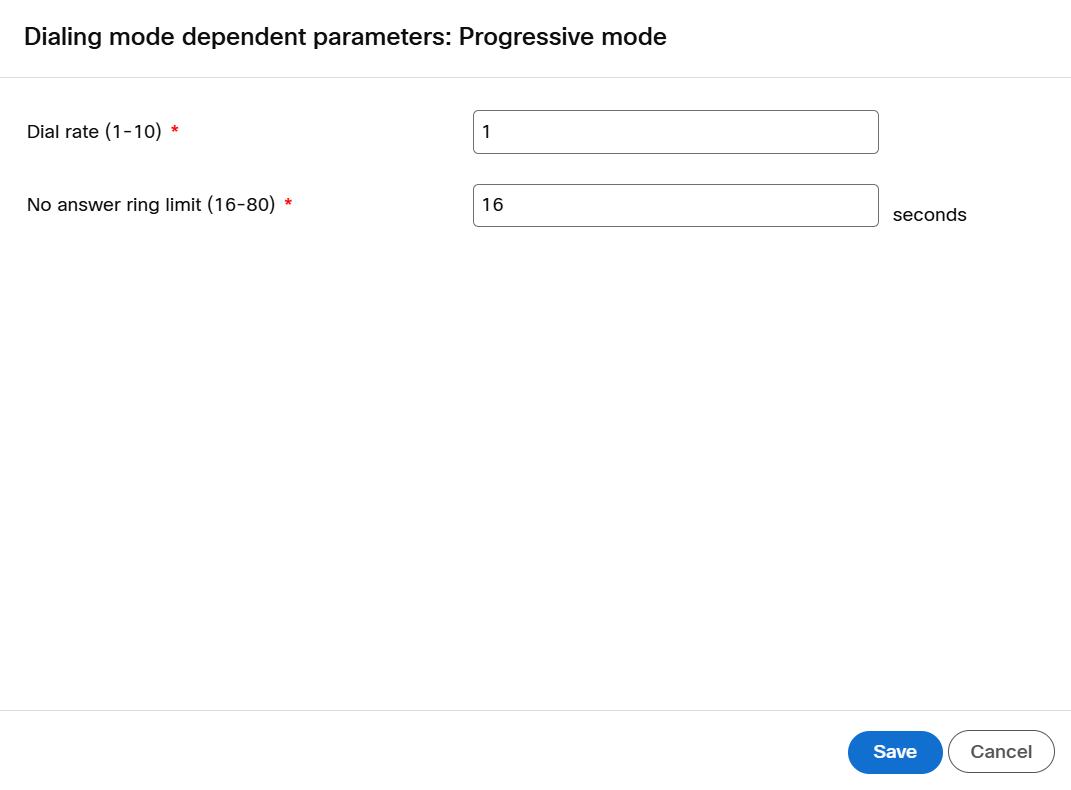
Predictive dialing mode dependent parameters
- Dial rate (1-10): It refers to the number of outbound calls is dialed out from a single port. The default value is 1.
- No answer ring limit (16-80): It refers to the number of times a phone rings before a call is considered unanswered and is either forwarded or sent to voicemail. This limit can be configured within the range of 16 to 80 rings. The default value is 32.
- Max dialing rate (1-10): It refers to the number of calls an IVR port can make simultaneously, typically between 1 and 10. This rate is relevant for outbound call campaigns, especially in progressive dialing scenarios. The default value is 2.
- Abandon rate percentage (1.0 - 100): The call abandonment rate is expressed as a percentage between 1.0 and 100, represents the proportion of calls that are hung up before they are answered by an agent. It's calculated by dividing the number of abandoned calls by the total number of calls and multiplying by 100. The default value is 3.
- Predictive correction pace (10-5000): It refers to the speed at which the system dials outbound calls in a predictive dialing campaign. It's a setting within the Predictive outbound campaign mode and determines how many calls are attempted simultaneously. The range for setting predictive pace is typically 10 to 5000. The default value is 70.
- Predictive gain (0.1 - 3.0): It refers to a dial rate adjustment factor that influences how many calls a Webex Contact Center server makes for each IVR port. This setting, along with the dial rate, determines the number of calls an IVR port attempts to make during a predictive campaign. The default value is 1.
- Reservation percentage (0-100): A reservation percentage (ranging from 0 to 100) can be assigned to agents in a call queue profile to influence how calls are distributed. This allows for weighting or prioritizing certain agents based on factors like skill level or availability, ensuring calls are routed to the most suitable agent. The default value is 100.
- Click Save.
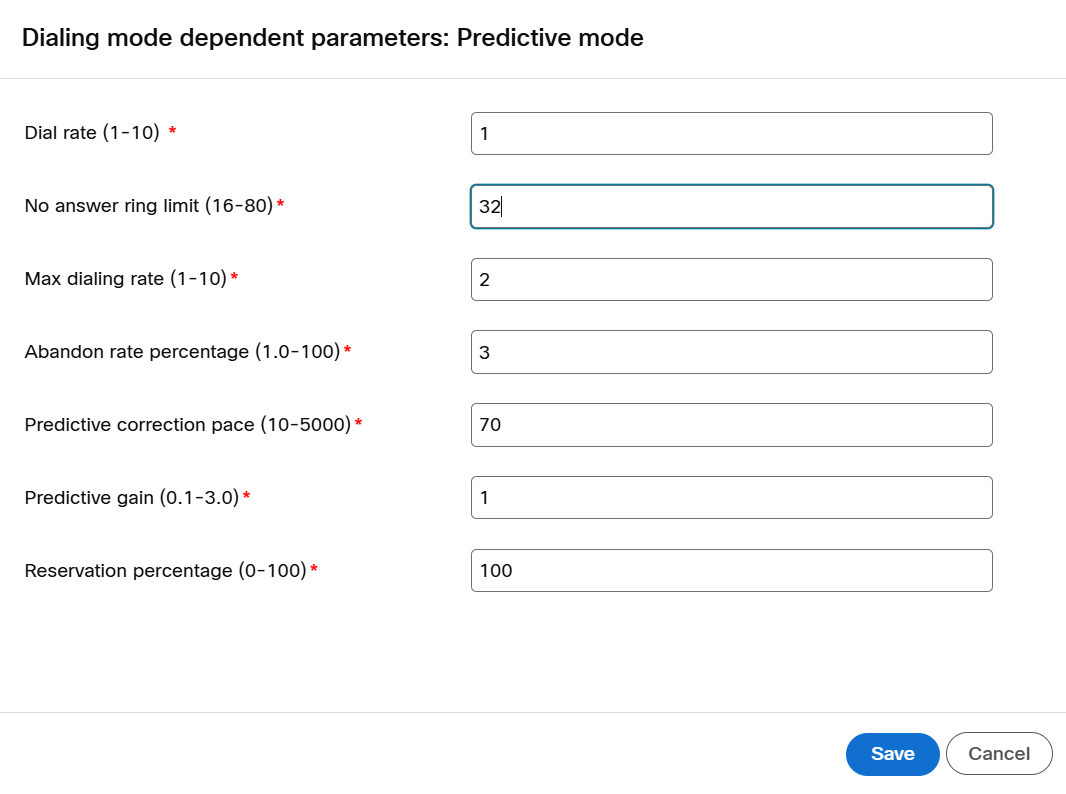
Progressive IVR dialing mode dependent parameters
- Dial rate (1-10): It refers to the number of outbound calls is dialed out from a single port.
- No answer ring limit (16-80): It refers to the number of times a phone rings before a call is considered unanswered and is either forwarded or sent to voicemail. This limit can be configured within the range of 16 to 80 rings. The default value is 32.
- IVR ports (1 - 1000):
- Click Save.
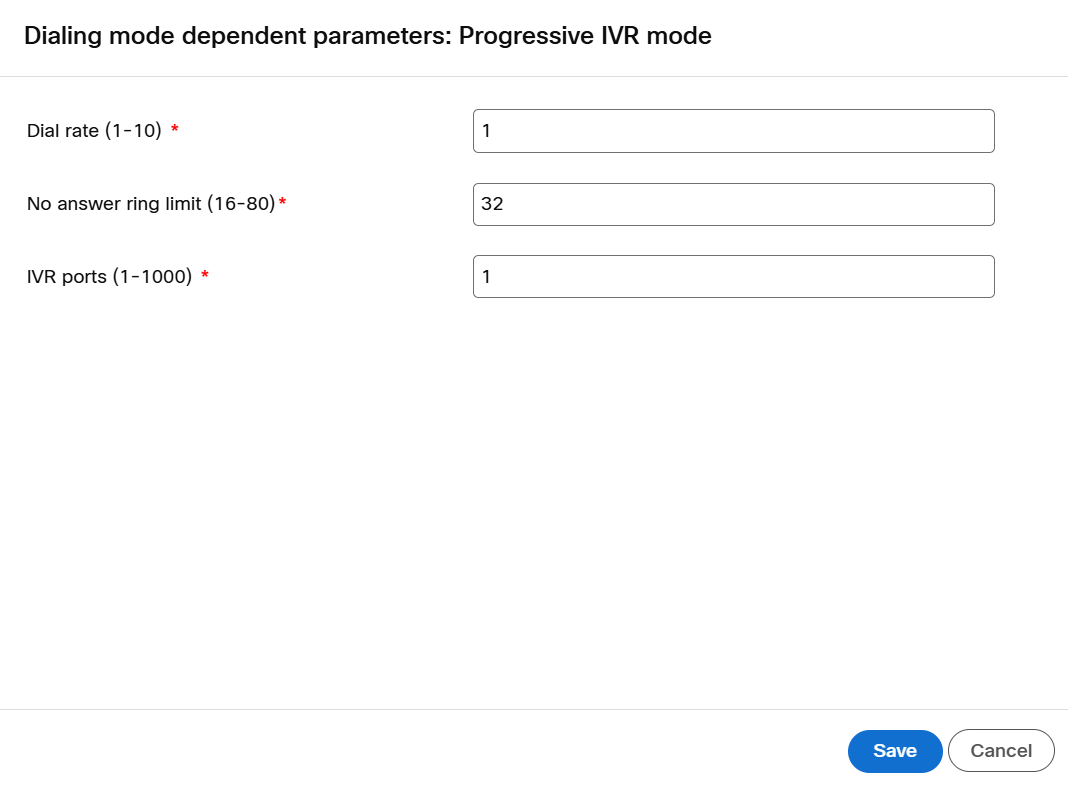
Predictive IVR dialing mode dependent parameters
- Dial rate (1-10): It refers to the number of outbound calls is dialed out from a single port.
- No answer ring limit (16-80): It refers to the number of times a phone rings before a call is considered unanswered and is either forwarded or sent to voicemail. This limit can be configured within the range of 16 to 80 rings. The default value is 32.
- Max dialing rate (1-10): It refers to the number of calls an IVR port can make simultaneously, typically between 1 and 10. This rate is relevant for outbound call campaigns, especially in progressive dialing scenarios.
- Abandon rate percentage (1.0 - 100): The call abandonment rate is expressed as a percentage between 1.0 and 100, represents the proportion of calls that are hung up before they are answered by an agent. It's calculated by dividing the number of abandoned calls by the total number of calls and multiplying by 100.
- Predictive correction pace (10-5000): It refers to the speed at which the system dials outbound calls in a predictive dialing campaign. It's a setting within the Predictive outbound campaign mode and determines how many calls are attempted simultaneously. The range for setting predictive pace is typically 10 to 5000.
- Predictive gain (0.1 - 3.0): It refers to a dial rate adjustment factor that influences how many calls a Webex Contact Center server makes for each IVR port. This setting, along with the dial rate, determines the number of calls an IVR port attempts to make during a predictive campaign.
- Reservation percentage (0-100): A reservation percentage (ranging from 0 to 100) can be assigned to agents in a call queue profile to influence how calls are distributed. This allows for weighting or prioritizing certain agents based on factors like skill level or availability, ensuring calls are routed to the most suitable agent.
- Preview offer timeout (max 7200): It refers to the time an agent has to accept or reject a call before the system considers the agent unavailable for that call. The maximum allowed timeout for a preview offer is 7200 seconds, which is equivalent to 2 hours. The default value is 600 seconds.
- Auto action after preview timeout: After preview timeout an agent session will usually be released back to the system and the call will be terminated. The agent can then accept or reject the call during the preview time (defaulting to 10 minutes). After the timeout, the system handles the call, often returning it to the dialer list for the next available agent. The default value is skip.
- Disable action for preview: You can select Skip or Remove.
- Click Save.
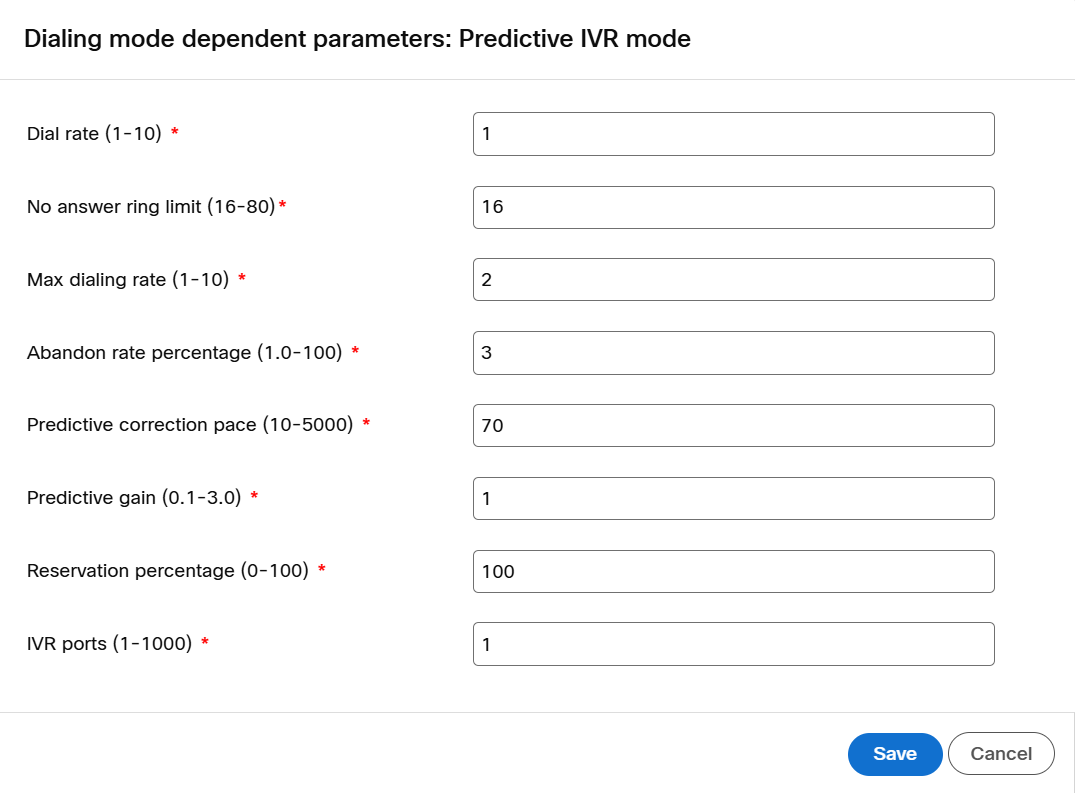
Updated about 1 month ago
